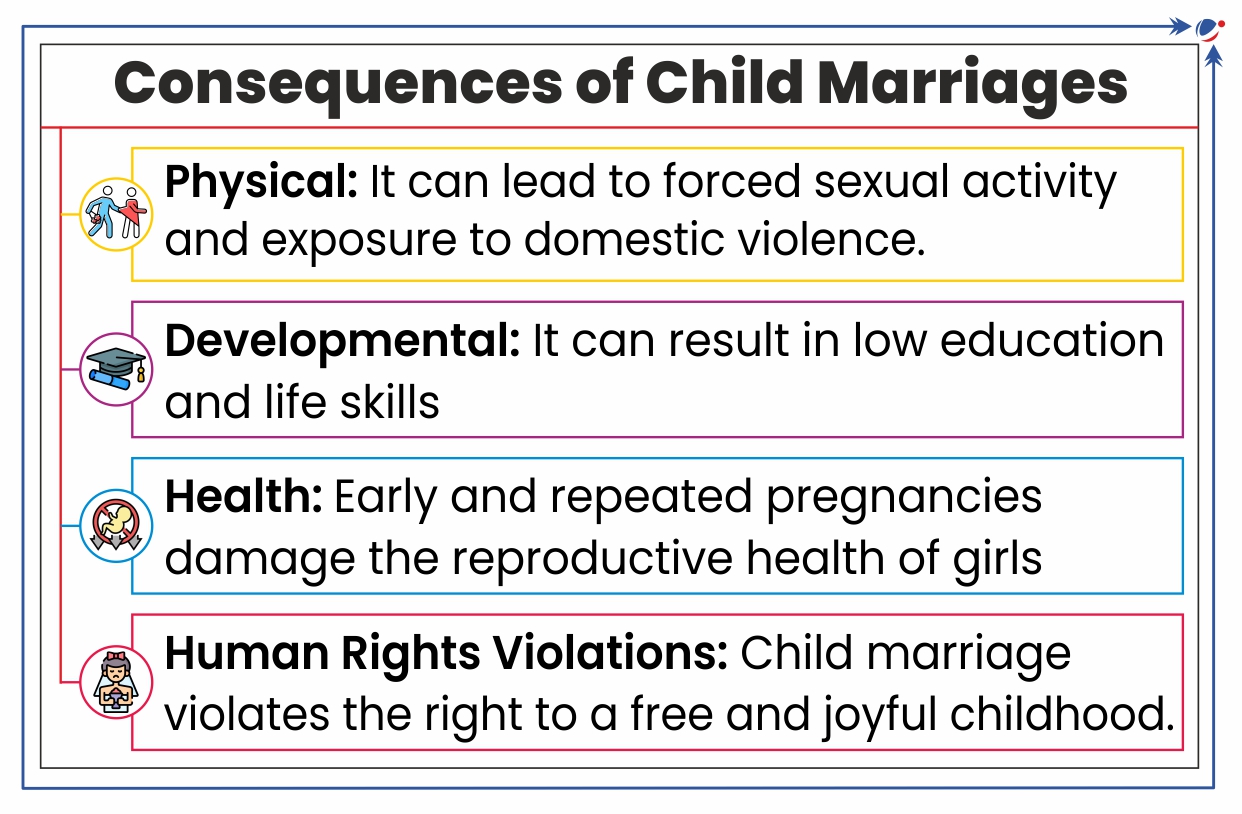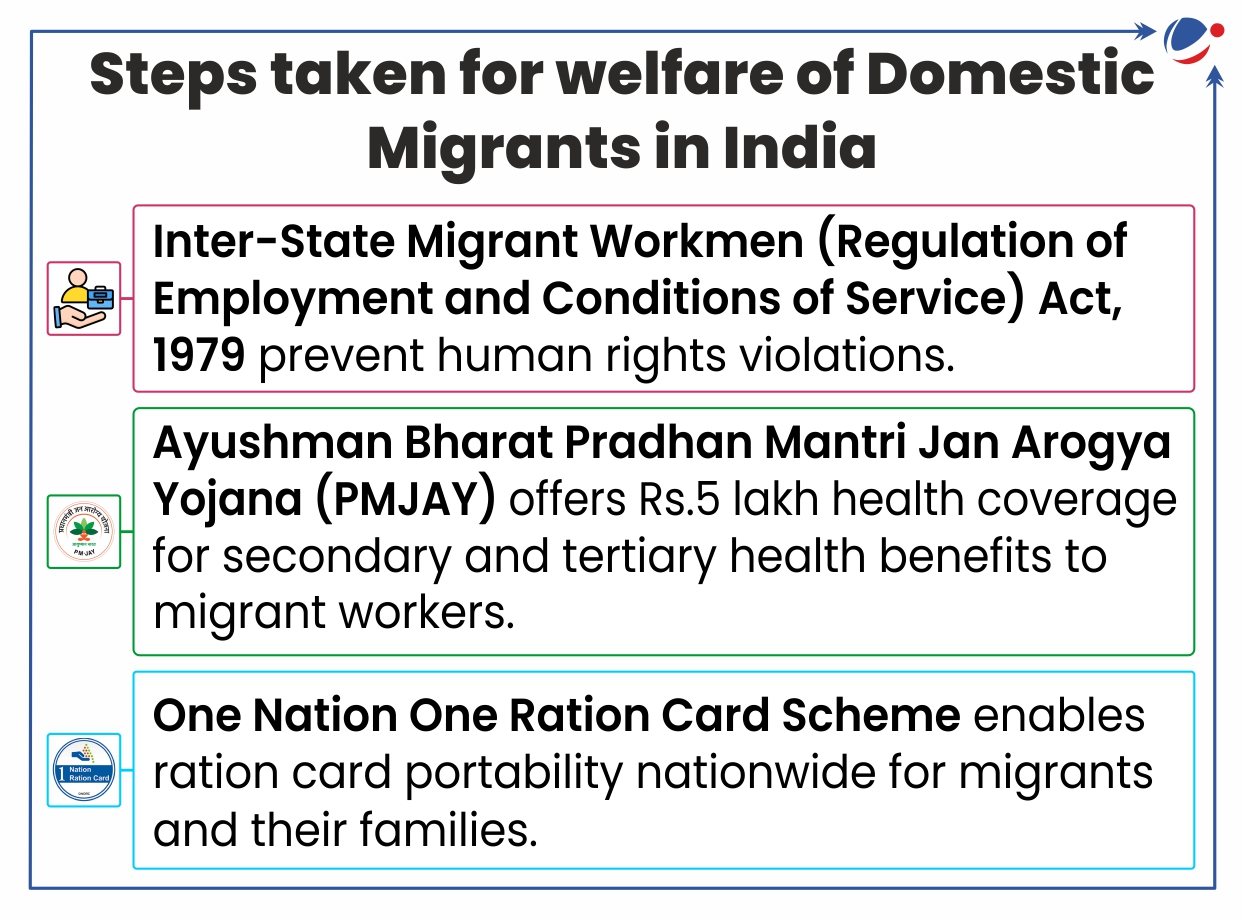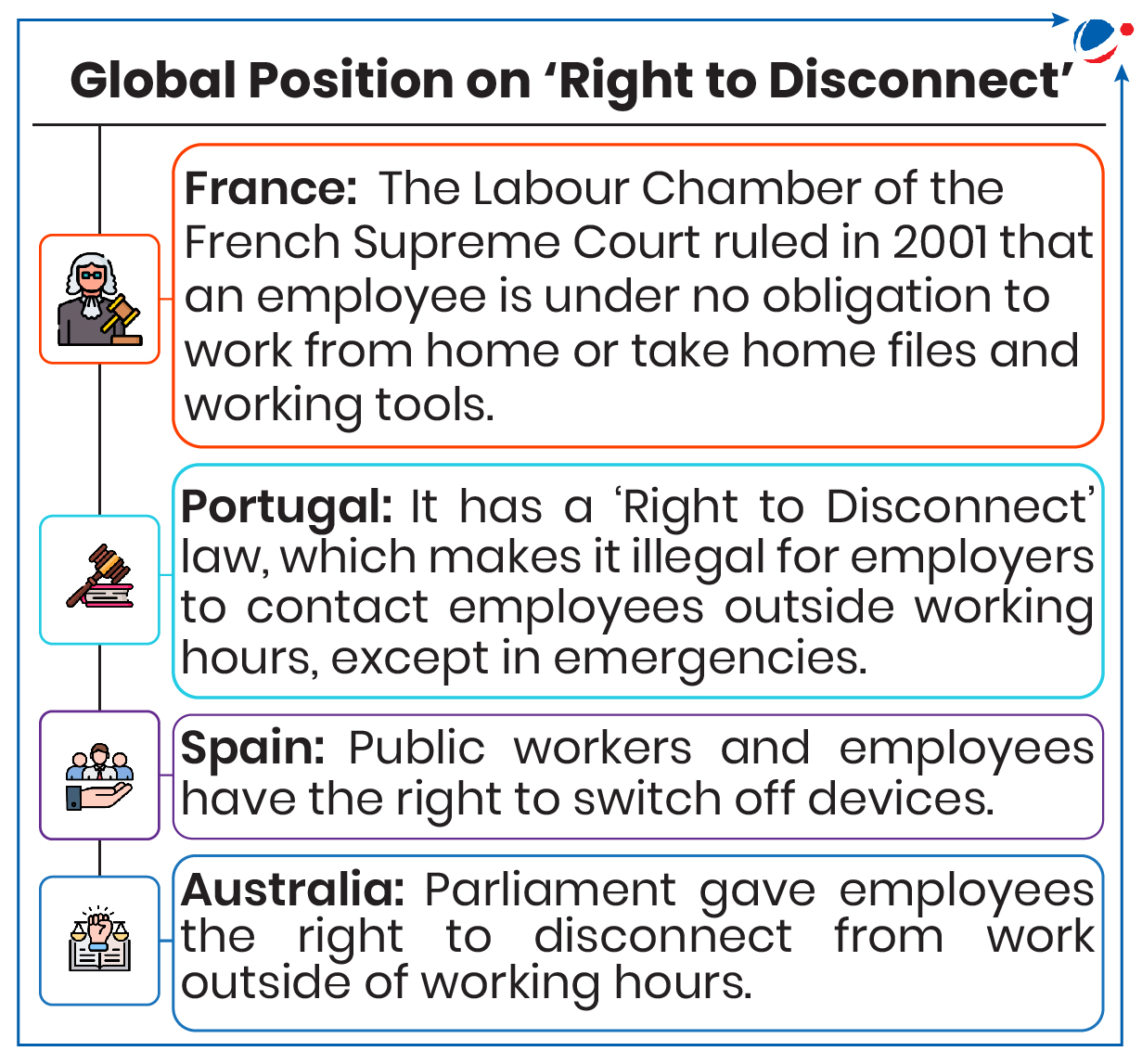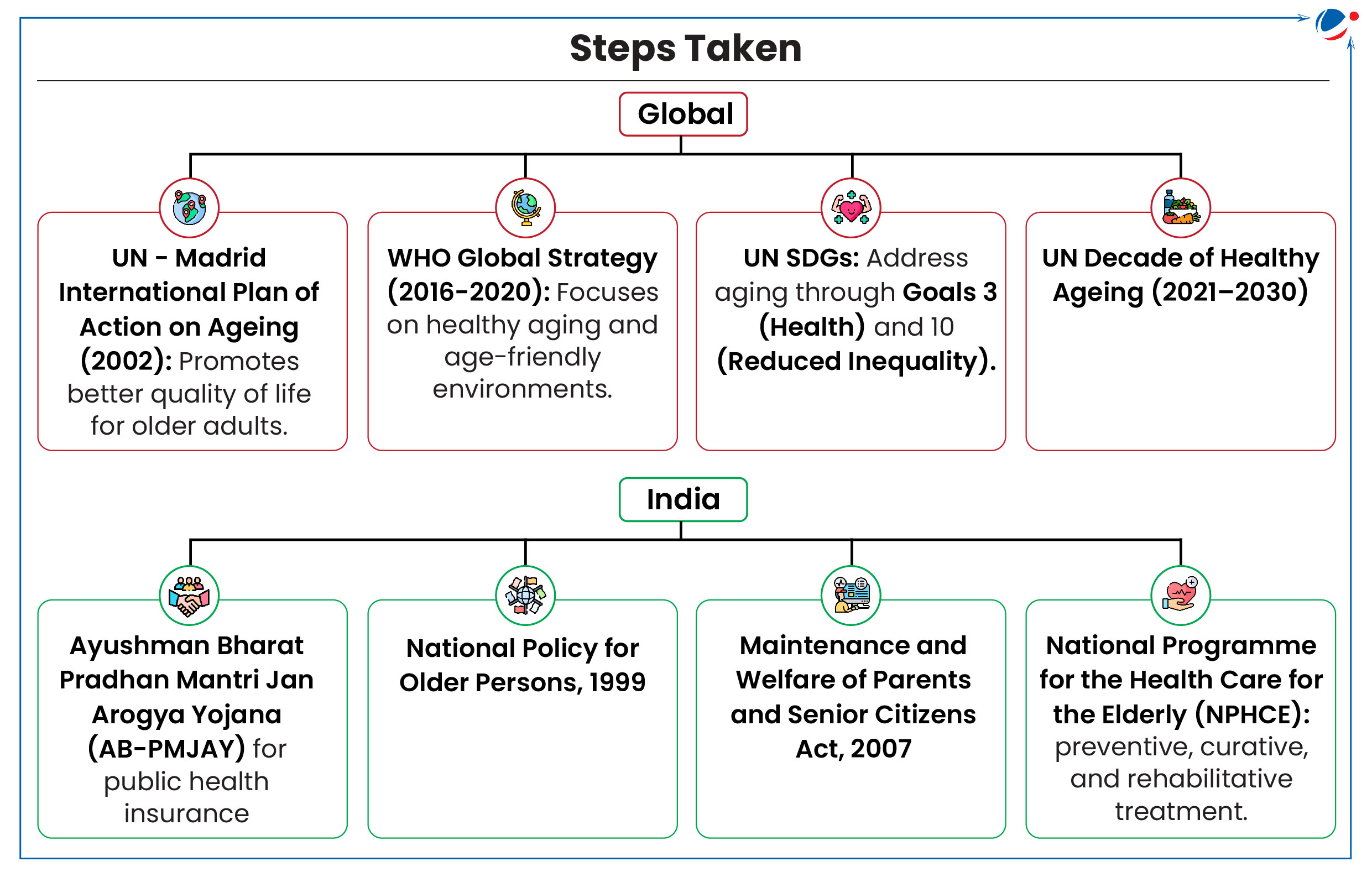JJM and Women Empowerment
Recently Prime Minister highlighted role of Jal Jeevan Mission (JJM) in empowering women in rural areas.
- Earlier a report by SBI also highlighted that 9 crore women no longer fetch water from outside owing to ‘JJM: Har Ghar Jal’ initiative.
Significance of JJM for Women Empowerment
- Skill Development: Water availability at doorstep allows women to focus on skill development and self-reliance.
- Also, time saved leads to a 7.4 percentage point increase in women’s participation in agriculture and businesses.
- Leadership: JJM mandates 50% of village water and sanitation committees members be women, prioritizing their needs in water planning, and enhancing leadership roles.
- Employment Opportunities: JJM is expected to generate 59.9 lakh direct employment boosting economic opportunities for women.
About JJM: Har Ghar Jal
- Nodal Ministry: Ministry of Jal Shakti
- Type: Centrally Sponsored Schemes
- Objective: Ensure every rural household has access to safe and reliable tap water by 2024.
- Goal: To develop ‘WASH Enlightened Villages’ wherein the local communities are equipped to provide long-term assured water supply and sanitation services to all.
- Focus on children: Piped water supply in schools, ocusing centres and ashramshalas
- Key Components: Ensuring Water Quality, Bottom-Up Planning, Source Sustainability, Greywater Management, and Skill Development & Employment.
- Key achievement: Rural coverage for tap water connection is raised to 79.31% from just 17% (3.23 crore households) in 2019.
- Tags :
- Jal Jeevan Mission
- WASH Enlightened Villages
- Bottom-Up Planning
Global One-Stop Centres (OSC)
Government has approved 9 global One Stop Centres (OSCs) for Indian women in distress by Ministry of External Affairs.
About Global OSCs
- Aim: To provide comprehensive assistance to women in vulnerable situations, addressing their immediate needs and offering critical support.
- They include 7 OSCs with provision of shelter homes in Bahrain, Kuwait, Oman, Qatar, UAE, Saudi Arabia (Jeddah & Riyadh) and 2 OSCs without shelter homes in Toronto and Singapore.
- Indian Community Welfare Fund (ICWF) will play a vital role in extending welfare measures to distressed Indian nationals, particularly women.
- ICWF, set up in 2009, stands extended to all Indian Missions and Posts abroad.
- Tags :
- Global One-Stop Centres
- Indian Community Welfare Fund
Bal Vivah Mukt Bharat Campaign launched
Union Minister for Women and Child Development launched ‘Bal Vivah Mukt Bharat’ (Child Marriage Free Bharat) campaign.
- The campaign calls on all citizens to actively oppose child marriage and is a collaborative effort between the Ministry of Women and Child Development and various other Ministries.

About the Campaign
- Focus Areas: In seven States with high burden of child marriages and in nearly 300 high-burden districts.
- Collaborative approach: Call on every State and Union Territory to devise an action plan aimed at reducing the child marriage rates below 5% by 2029.
- Child Marriage Free Bharat Portal: An innovative online platform that enables citizens to report child marriage incidents, file complaints, and access information about Child Marriage Prohibition Officers (CMPOs) nationwide.
Status of Child Marriage in India
- Reduction in Child Marriage: As per NFHS-5, Child marriage has decreased from 47.4% in 2005–06 to approximately 23.3% during 2019-21.
- Variation by household wealth: According to NFHS-5, 40% of females in the lowest quintile married before the age of 18, compared to only 8% in the highest quintile.
- States with high prevalence: West Bengal, Bihar, Tripura, Jharkhand, Assam, Andhra Pradesh, Rajasthan and Telangana.
Steps taken by government
- Prohibition of Child Marriage Act, 2006 (PCMA): Prohibits child marriages where females are under 18 and males are under 21.
- United Nations Convention on the Rights of the Child: India is a signatory which mandates the protection of children from harmful practices, including child marriage.
- National Commission for Protection of Child Rights (NCPCR): Runs awareness programs to fight child marriage.
- Sustainable Development Goals (SDGs): India has committed to achieve SDG 5, which aims to eliminate all harmful practices, such as child, early, and forced marriage, by 2030.
- Convention on the Elimination of All Forms of Discrimination Against Women (CEDAW): India has ratified the CEDAW.
- Tags :
- Child Marriage
- UN Convention on the Rights of the Child
- Bal Vivah Mukt Bharat
- Prohibition of Child Marriage Act, 2006
Domestic Migration Report by EAC-PM
Report on domestic migration released by Economic Advisory Council to the Prime Minister (EAC-PM)
- Report titled ‘400 Million Dreams’ highlights the changing patterns of migration in India since 2011 Census.

- Internal/Domestic migration refers to movement of people within a country from one region to another.
- Push factors: Lack of job opportunities, natural disaster, lack of quality education and healthcare facilities, etc.
- Pull factors: Economic opportunities, higher standard of living, peace and stability, etc.
Key Findings of report
- Reduction in Domestic Migrant Numbers: By about 12% from 45.57 crore to 40.20 crore in 2023 with migration rate dropping from ~38% to an estimated ~29% in 2023.
- Migration Dynamics:
- Short-distance migration is predominant, with distance negatively affecting labour mobility.
- Migration originates primarily from areas around major urban centers like Delhi, Mumbai, Chennai, Bangalore, and Kolkata
- Major Migration Routes: UP-Delhi, Gujarat-Maharashtra, Telangana-AP, Bihar-Delhi (state level).
- Increase in Migrant Share: West Bengal, Rajasthan, and Karnataka have seen an increase in percentage of arriving migrants.
- Decrease in Migrant Share: Maharashtra and Andhra Pradesh experienced reduction in their share of total migrants.
Reasons for decline in migrant numbers
- Improved infrastructure (roads, education, healthcare, public transport), social security nets etc. at place of origin.
- Localized economic growth creating jobs closer to rural areas.
- Tags :
- EAC-PM
- Domestic Migration
- Inter-State Migrant Workmen Act, 1979
‘Right to Disconnect’ in India
Recently, various sections in India have raised voices on the need to bring a law on ‘Right to Disconnect’ in the backdrop of death of a young female employee due to work stress.
- 'Right to Disconnect' means that employees are not obliged to reply to calls made by employers after work hours and such an employee shall not be subject to any disciplinary action by employers.

Need for ‘Right to Disconnect’ in India
- Psycho-Social: Weakens social bonds and leads to isolation and may even elevate risk of mental health issues, cardiovascular diseases, etc.
- Impact on women: A recent report reveals that Indian women in professional jobs, such as auditing, IT, and media, work more than 55 hours a week.
- Others: Loss of productivity; insomnia, disrupted sleep cycles, etc., due to prolonged screen time, among others.
Status of ‘Right to Disconnect’ in India
Currently, India lacks specific laws recognizing right to disconnect from work.
- Constitutional Provisions: Article 38 (directs state to promote welfare of people) and Article 39(e) (directs state to secure strength and health of its workers).
- Judicial pronouncements: Vishakha v State of Rajasthan, 1997 (on safe working environment for women), Ravindra Kumar Dhariwal and Ors v. UoI, 2021 (accommodate persons with disabilities).
- Recent Initiative: In 2018, a Private Member’s Bill was introduced in Lok Sabha, which aimed to delineate the right to disconnect from work after working hours.
- Tags :
- Work-Life Balance
- ‘Right to Disconnect’
- Article 38
- Article 39(e)
No Detention Policy
Ministry of Education scraps ‘no detention’ policy for Classes 5 and 8 for the schools under the Centre.
- The new policy allows schools to fail students who do not pass their year-end exams under the new Right of Children to Free and Compulsory Education (RTE) (Amendment) Rules, 2024.
- The no-detention policy was part of the Right to Education (RTE) Act, 2009 aiming to reduce dropout rates.
- 16 states and 2 Union Territories, including Delhi, have already adopted this policy, as education is a State subject.
Key points regarding the new policy
- Although the no-detention policy was abolished from the RTE Act in 2019, the implementation was delayed waiting for the National Curriculum Framework, released in 2023.
- If a student fails to meet promotion criteria, they will receive additional instruction and a chance for re-examination within two months from result declaration.
- No child can be expelled from school until they complete elementary education.
Arguments for Detention
- Decline in learning outcomes: as >65 lakh students failed in classes 10 and 12 (2023)
- Lack of incentives: automatic promotion takes away motivation from students to work hard and reduces accountability of teachers.
Arguments for no Detention
- Stigmatization and higher dropout rates: due to fear of failure and being forced to repeat classes
- Child centric learning: promoting an educational system valuing holistic development of a child rather than just academic performance.
About RTE Act, 2009
|
- Tags :
- No Detention Policy
- RTE Act, 2009
- 86th Constitution Amendment
- RTE (Amendment) Rules, 2024
WFP Global Outlook for 2025
World Food Programme (WFP) released ‘Global Outlook for 2025’ Report.
- It provides updates on global food security & highlights solutions WFP can offer to respond to crises, and tackle root causes of hunger.
Key Highlights
- Global Hunger Crisis: An estimated 343 million people across 74 countries are acutely food insecure, with 1.9 million people on the brink of hunger.
- Key Factors: Armed violence is a key driver in 14 out of 16 hunger hotspots like Sudan, Gaza, etc. Other factors includes food Inflation, extreme weather events etc.
- 65 % of acutely food-insecure people live in fragile/conflict-affected situations.
- Funding Requirement: WFP requires US$16.9 billion to provide critical assistance to 123 million of most vulnerable people facing food insecurity worldwide.
- India Specific:
- India is home to a quarter of all undernourished people worldwide.
- Around 21.25 % of population lives on less than US$1.90 a day.
- 38% of children aged 6-59 months grappling with chronic malnutrition.
- India is home to a quarter of all undernourished people worldwide.
WFP’s Approach to Combating Hunger
- Investing in local nutritious food solutions, fortification & social protection systems, to reduce needs in long term.
- Empowering vulnerable communities to withstand shocks through improved livelihoods, climate protection etc.
- Other: Increasing institutional capacity at local level, address gender inequalities affecting food insecurities etc.

- Tags :
- Food and Agriculture Organization
- World Food Programme
- Global Outlook for 2025
Articles Sources
Anna Chakra Tool
The Union Minister of Consumer Affairs, Food and Public Distribution launched the ‘Anna Chakra’ PDS Supply Chain optimization tool and SCAN Portal to modernize the PDS system.
About Anna Chakra
- It is a Public Distribution System (PDS) Supply Chain optimization tool that leverages advanced algorithms to identify optimal routes and ensure seamless movement of food grains.
- It is an initiative of the Department of Food Public Distribution developed in collaboration with the World Food Programme (WFP) and IIT-Delhi.
- It is Integrated with the PM Gati Shakti platform and FOIS (Freight Operations Information System) portal of the Railways through the Unified Logistics Interface Platform (ULIP).
About SCAN (Subsidy Claim Application for NFSA) Portal
- Aims to provide a single window submission of subsidy claims by states, claim scrutiny and approval by Department of Food and Public Distribution facilitating expeditious settlement process through end-to-end workflow automation.
- Tags :
- Anna Chakra
- PDS Supply Chain
- SCAN Portal
- Subsidy Claim Application for NFSA




